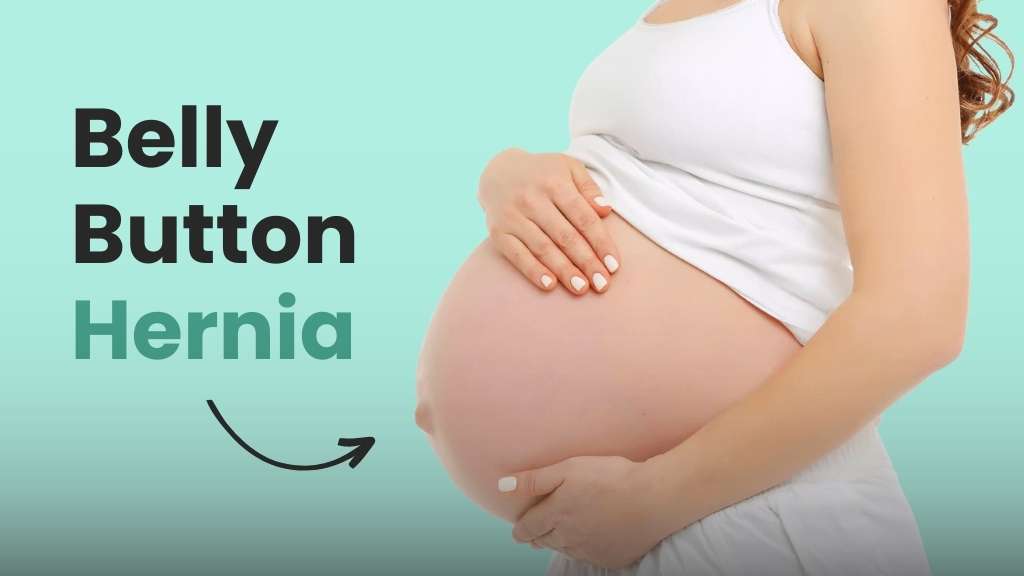
Table of Contents
One of the initial exciting moments for new parents is anticipating the healing process of their baby’s belly button. After devoting a week or two to carefully ensuring the proper drying and prevention of infection in the umbilical cord stump, it eventually detaches, revealing the navel. Occasionally, this belly button can become a source of worry if it appears larger or feels firm.
As a part of the natural progression during a baby’s time in the womb, the muscles just beneath the navel come together to form what’s called the umbilical ring. However, on occasion, these muscles don’t fully close, leaving a small opening. Following birth, this opening can lead to the intestines protruding, resulting in an umbilical hernia.
What is a Belly Button Hernia or Umbilical Hernia?
An umbilical hernia is like a strange lump that can show up around your belly button. This happens because some of the stuff inside your tummy, like the lining, a piece of the intestine, or even some belly fluid, pokes through a hole in the tummy muscle. These hernias are pretty normal and happen to about 10 to 20 out of every 100 kids. They’re more often seen in African-American children and in babies who were born early or were very small. Boys and girls both can get them.
Causes of Belly Button Hernia
A hernia occurs when a section of the intestine pushes through a muscle wall that’s meant to keep it in place. An umbilical hernia is when this happens around the belly button area, specifically at a spot in the tummy’s muscle wall called the umbilical ring.
The umbilical ring is a muscle that encircles the belly button. When a woman is pregnant, the umbilical cord goes through this ring to provide nourishment and blood to the growing baby. Normally, the umbilical ring closes shortly after the baby is born. But if it doesn’t close properly, parts of the intestine might come through. This can lead to a noticeable bulge close to the baby’s belly button, especially when they cry, cough, or strain.
Belly Button Hernia Symptoms
Normal Umbilical Hernia
Umbilical hernias show up as a bump or swelling around the belly button. You might notice the swelling more when the baby cries, and it could go down or even vanish when the baby is calm. If a doctor gently presses on the bump while the child is lying down and is not upset, it will usually become smaller or go back inside the belly.
Incarcerated Umbilical Hernia
Sometimes, the intestines can get stuck in the umbilical hernia. This belly button hernia symptom is called an incarcerated hernia. When this happens, the child usually feels intense pain and the bump might feel hard and red. It’s really important for the doctor to quickly check for an incarcerated hernia to make sure the intestines aren’t getting hurt. This doesn’t happen very often.
Diagnosis of Belly Button Hernia
Medical professionals identify an umbilical hernia by examining and touching a raised or swollen area near the belly button. This bump usually becomes more prominent when the baby is crying and shrinks or disappears when the baby is calm or lying on their back.
The doctor might softly attempt to manipulate the hernia to return it to its correct position within the abdomen. A hernia that can be pushed back into place is referred to as a “reducible” hernia. This indicates that the intestine isn’t trapped (“incarcerated”) within the opening of the muscle wall.
Treatment for Belly Button Hernia
Most belly button hernias in kids are usually not a big deal. They often get better on their own before a child turns 4 or 5. Surgery is only needed if:
- The hernia doesn’t close on its own by the time the child is 4 or 5.
- The hernia gets stuck and can’t be pushed back in easily.
If surgery is needed, doctors will:
- Give medicine to make the child sleep during the surgery, so they won’t feel any pain.
- Make a small cut in the skin.
- Put the intestine back where it should be.
- Stitch up the hole or weak area in the muscle.
- Close the cut with stitches under the skin and tape. The tape will come off on its own in 7-10 days.
Sometimes, kids might need surgery right away if the intestine is stuck and can’t be pushed back in. This can hurt the intestine.
At home, you can try to gently push the hernia back in but don’t use tape or anything else to hold it in. Using tape won’t make it go away and might cause infections along with other belly button hernia symptoms.
When To See A Doctor?
Umbilical hernias often close by themselves without needing surgery. It’s important to keep an eye on the belly button hernia symptoms to observe any changes. If your child still has a hernia after turning 5 years old, you should contact the doctor. Get in touch with the doctor immediately if:
- The hernia becomes larger, seems swollen, or feels hard.
- The hernia protrudes when your child is sleeping, relaxed, or lying down, and you can’t push it back in.
- Your child is very irritable or appears to be in pain.
- Your child experiences pain when the hernia is touched.
- The skin covering the hernia becomes red or appears darker than usual.
Risk factors of Belly Button Hernia
Umbilical hernias are most often seen in babies, especially those born prematurely or with low weights. Among babies in the United States, it seems that black infants might have a slightly higher chance of getting these hernias. Both boys and girls can have this condition. When it comes to grown-ups, being overweight or having several pregnancies might raise the likelihood of getting an umbilical hernia. This kind of hernia is more frequently found in women.
Complications of Belly Button Hernia
Umbilical hernias in kids usually don’t cause many problems. Sometimes, though, things can get tricky if the part of the tummy that sticks out gets stuck and can’t be pushed back in. This can block the blood flow to that part of the belly make it hurt, and even harm the tissue there.
If the bit of the tummy that’s stuck loses its blood supply completely, it can start to die. This might let an infection spread in the belly, which could be really dangerous and even life-threatening.
An Endnote
Umbilical hernias are like small bulges near the belly button, often seen in babies. Most of these hernias close by themselves, about 80% of the time, usually by the time the child is three or four years old. But sometimes, they don’t close on their own. If the hernia can’t be gently pushed back in or if it’s cutting off blood supply to the intestines, it’s a problem.
In these cases, doctors will do a surgery to fix it. This kind of surgery is quite common in kids. If the child’s heart and blood are healthy, the surgery is done as a day procedure, and recovery is pretty quick.
If you see the hernia becoming very swollen, changing color, or being painful, or if your child is throwing up or hurting a lot, you should rush to the emergency room right away. If things seem okay but you’re not sure, it’s still a good idea to see the child’s doctor from time to time. This way, the doctor can check and make sure the hernia is getting better.










